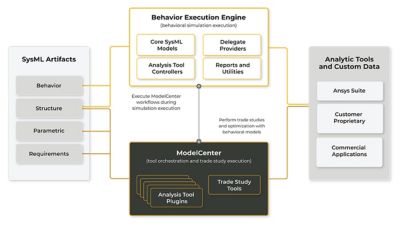-
United States -
United Kingdom -
India -
France -
Deutschland -
Italia -
日本 -
대한민국 -
中国 -
台灣
-
Ansys stellt Studierenden auf dem Weg zum Erfolg die Simulationssoftware kostenlos zur Verfügung.
-
Ansys stellt Studierenden auf dem Weg zum Erfolg die Simulationssoftware kostenlos zur Verfügung.
-
Ansys stellt Studierenden auf dem Weg zum Erfolg die Simulationssoftware kostenlos zur Verfügung.
-
Kontakt -
Karriere -
Studierende und Akademiker*innen -
Für die Vereinigten Staaten und Kanada
+1 844,462 6797
ANSYS BLOG
January 25, 2023
Models Behaving Badly Cost Millions: Finding Solutions with BEE
Sorry, this is not an article about Hollywood celebrities causing trouble. This is actually about digital mission engineering transforming the aerospace and defense (A&D) industries to provide a better future for the next generation of Americans. Do we still have your attention?
You may have heard that digital mission engineering is one of the latest trends in A&D due to its ability to dramatically reduce costs and delivery timelines for complex systems. Digital mission engineering includes using integrated data and process management systems, wide ranging, complex analytic simulations, and model-based systems engineering (MBSE).
One of the most challenging aspects of the traditional approaches is testing and understanding complex system behaviors without conducting expensive and time-consuming physical tests. National security systems make this even more challenging because it may be impossible to truly test the designed behavior in a realistic mission environment. Any inability to effectively test the behaviors of your system, under realistic conditions, can lead to expensive cost overruns, programmatic delays, or ineffective capabilities.
Advanced simulations with tools like Ansys Systems Tool Kit (STK) and Ansys HFSS can save costs by reducing the number of flight tests required for advanced aircraft systems. Other studies have shown a 55% reduction in the development costs of complex projects by using MBSE practices.
As MBSE practices have developed and matured, systems modeling language (SysML)-based models have emerged as an integral part of MBSE implementations. SysML is a language that supports architectural modeling of systems and has many benefits, but like any technology, must be properly applied. The most rigorous application of SysML creates a system architecture that not only describes the system correctly, completely, clearly, concisely, and consistently, but also allows the system to by simulated so that its performance can be predicted.

Of course, adopting MBSE and embracing SysML is not something that happens overnight, especially for organizations with well-established engineering practices. Ansys works with organizations across all stages of MBSE adoption — some in the early stages, while others have mature MBSE ecosystems in place. For the former, the question of where to start is often at the forefront, and the overall task can appear overwhelming before a path forward is established. For the latter, tool and process integration is typically a focus.
You and your colleagues can realize the full potential of digital mission engineering when analytic simulations are driven by the same descriptive and behavioral MBSE models. This fundamentally enables you to simulate, quantify, and verify whether the digital prototypes you have designed can satisfy mission requirements. Linking MBSE behaviors to analytic simulations is what Ansys ModelCenter’s Behavior Execution Engine (BEE) is designed to do.
BEE is a model execution and integration engine for executable architectures. It contains a set of capabilities that integrate your MBSE artifacts, mission environments, and physics-based analysis tools to create time-synchronized, event-based, physics-enabled simulation. BEE simulates and evaluates interactions between your models and their common operating environment to predict mission outcomes and assess capability performance.

The combination of behaviors described via SysML state machines, driving analytic simulations in STK, enables you to execute hundreds or thousands of test cases to evaluate how the system actually responds while performing its designed behavior. If you make changes to the designed behavior, you can re-execute the system to verify performance, identify improvements, or find unexpected faults earlier, faster, and at a much lower cost.
Learn more about BEE and how digital engineering and MBSE can help you.










